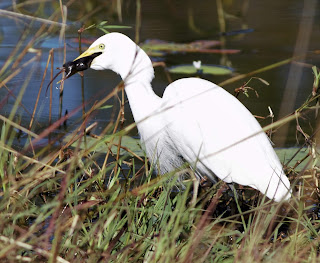 |
| Barking Owl - Sheepstation Creek |
BirdLife Australia Sunshine
Coast, our local birding group, has for some time been running a game
on its Facebook page organised by its leader, Ken Cross. One
objective is to encourage people to photograph as many species as
possible in a calendar year in the Sunshine Coast region. The area
extends north to Inskip Point and Bauple; south to Bribie Island; and
west to Kilcoy, the Conondale Range, the Amamoor area and Muna
Creek-Miva. An outlier to the south, Sheepstation Creek Conservation Reserve near
Burpengary, is also included.
I thought it would be fun to join in for the 2018 game, and it's proved quite a challenge. A bit like a big jigsaw puzzle, with all the bits slowly falling into place. A few weeks ago, what I dubbed The Game morphed into a Big Year for me, so I'm keen to see how many species in the region I can photograph this year. As of 24/6/2018, I'm up to 279, and while it might be nice to hit 300, another 21 is a tall order, especially since I'm away for much of the second half of the year. I've seen but not managed to photograph another 6 species (Black-tailed Native-hen, King Quail, Stubble Quail, Eastern Ground Parrot, Swift Parrot, White-throated Nightjar). I've seen a total of 344 species in the Sunshine Coast region since time immemorial.
Among recent forays was a visit to Imbil State Forest at Stirling Crossing, not far west of Imbil. Little Lorikeet was added to the list here and it was nice to see Dusky Woodswallow close up.
 |
| Dusky Woodswallow |
 |
| Little Lorikeet |
I
moved on to another part of the state forest near Brooloo, where I had
a fantastic close encounter with a female Black-breasted Buttonquail.
Also of interest here were more Little Lorikeets and a Black-chinned
Honeyeater. The
honeyeater
is a rare winter visitor to the region and I'd seen it just the week
before along
Amamoor
Creek Road.
 |
| Black-breasted Buttonquail |
 |
| Black-breasted Buttonquail |
On another trip I
decided to head to the northern sector of the area, where I found a
group of White-winged Choughs outside Bauple.
 |
| White-winged Chough |
I then had a look at
the Muna Creek-Miva area a bit further west, concentrating on the excellent open
woodlands along Munna Miva Road. I found Speckled Warbler along here. Nearby along Sexton Road I found two groups of
Grey-crowned Babblers.
 |
| Grey-crowned Babbler |
 |
| Speckled Warbler |
In more open country
I saw a Rufous Songlark, unexpected at this time of year.
 |
| Rufous Songlark |
We camped for two nights at Charlie Moreland Park, an old favourite. Yellow
Thornbill had been seen along the road in by Ian Stargazer and while
I didn't expect them to be still around, a party of 6 were in the
same area.
 |
| Yellow Thornbill |
In the forest above
the park along Sunday Creek Road I tracked down a Sooty Owl. A
Russet-tailed Thrush was finally connected with at nearby Booloumba
Creek camping ground. This was the first bird I photographed for The
Game back in January, but I discarded those lousy images and it was
another 6 months before I scored again.
 |
| Russet-tailed Thrush |
 |
| Sooty Owl |
I visited
Sheepstation Creek to chase up a Barking Owl which Matt Wright kindly
pointed me towards. This was my first sighting of the species in the
region. I also found a Square-tailed Kite in the reserve.
 |
| Barking Owl |
 |
| Square-tailed Kite |
A Wedge-tailed Eagle
(the third for The Game) was seen at Toorbul.
 |
| Wedge-tailed Eagle |
I thought another
trip north was in order. I saw a flock of 20 Red-tailed Black
Cockatoos at Scotchy Pocket – not new for The Game because I had them at Amamoor, but nice.
 |
| Red-tailed Black Cockatoo |
I overnighted in the
pub at Tiaro, just north of the area for The Game, and was delighted
to find a Barking Owl along the Mary River - my second encounter with
the species in a few days.
 |
| Barking Owl - Tiaro |
I again visited the
Munna Miva Road, this time connecting with a group of
Weebills; this species is inexplicably scarce in the region. I also
found Black-chinned Honeyeater again -the third time for The Game.
 |
| Weebill |
 |
| Black-chinned Honeyeater |
Back on the home
front at Ninderry, a Square-tailed Kite has been frequenting the
garden area.












































